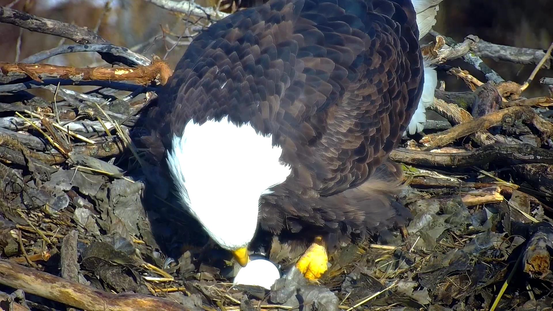|
February 15, 2023
 female turning the first egg
February 15, 2023
Congratulations everyone, we have our first egg of the 2023 season! We are so excited to share the happy news with you!
The first egg came around 12:30 PM today. The pair has been preparing the bole with soft grasses and leaves for a few weeks. The last few days, the female has been slowing down, spending more time in the nest and the male has been bringing food to her in the nest. These were all signs that an egg was imminent.
What happens next?
Additional eggs will likely come over the next few days - usually two or three days apart. We say usually because there can be up to five days between eggs.
The count to hatching begins today. This first egg is expected to hatch after 34-39 days of incubation. Frequent turning of the eggs helps the eggs develop properly. When turning the eggs, the adults curl up their talons in order to not injure it. They use their beak to gently roll the eggs between their feet, then reposition. Both adults develop an "egg patch" on their stomach which allows the the bare skin to keep the egg warm for development.
What is that sound?
On January 20, a new microphone was installed at the nest! Having sound is very exciting and brings new enjoyment for cam viewers. Recent territorial battles have been seen and can now also be heard. Sound can increase the drama of the powerful battles that can occur at the nest, but also improves understanding of how eagles communicate. In addition to adding the microphone, a branch that was obstructing the nest view was also removed. The camera was also re-secured and greatly improved the image quality!
Bald eagle vocalizations
Bald eagles make three or four main types of calls. They are generally referred to as the chatter call, peel call, wail call and chirp or whistle call. Biologists have long been studying what these various calls mean and when eagles use them. Turns out, much like people, eagles make a wide variety of noises for a variety of reasons and we don’t fully understand what every call means.
Calls are most often used for communicating with other eagles (what biologists call conspecifics), communicating with or deterring threats to their nest or territory and signaling readiness for mating, feeding or other group activities. Some biologists have even found fascinating evidence that individual eagles have uniquely identifiable voices.
Some other interesting eagle vocalization facts:
- Eagles are generally considered to make a “wimpy,” “weak,” or “insufficiently impressive” call for such large majestic birds!
- Most often on TV and film when an eagle shown majestically in flight, it is accompanied inaccurately by the piercing cry of the Red-tailed hawk.
- Eagles are thought to hunt mostly quietly and their calls do not seem frightening to other birds.
- Bald eagles are thought to have different regional dialects across different parts of their North American range.
- Female Bald eagles tend to make lower pitched calls.
- Vocalizations help us understand just how sensitive eagles can be to human disturbance. Some studies have found that human activity near eagles increased agitation (as demonstrated by vocalization) by about 300% to 400%.
- Eagles will often accompany their squeaky alarm calls with a vertical head toss, keep an eye out for that on our cam!
- When an egg is close to hatching, chirping from the chick might be heard from inside the egg!
You can see (song sonograms) and hear examples of eagle vocalization on many places online, here are a few: Bald Eagle on Bird of the World, The Cornell Lab, All About Birds, Bald Eagle Sounds, American Eagle Foundation Bald Eagle Behavior
Our deep appreciation goes out to Xcel Energy, All State Technologies, MNIT (Minnesota Information Technology) and YOU, our donors for the new microphone and the EagleCam. The support every one of you provide to the Nongame Program is deeply appreciated! Thank you!
Visit the DNR EagleCam: mndnr.gov/eaglecam
Donate to the nongame tax checkoff when you file your MN state taxes to help support the EagleCam!
|